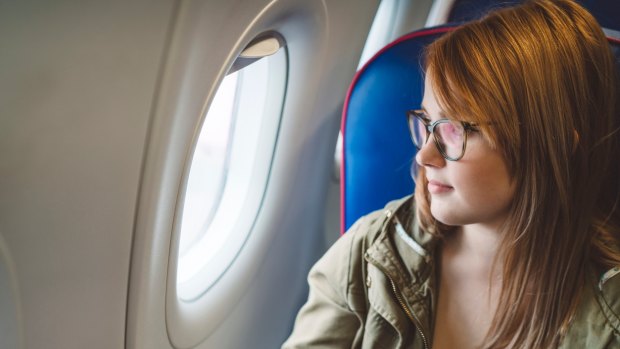This was published 3 years ago
Qantas sightseeing flights slammed over carbon emissions, but are they really such a bad idea?
Seven or eight months ago it would have seemed like the worst idea in the world: drive to the airport, get on a plane, fly for seven or eight hours and go… nowhere. Land back where you started. Get in your car and go home.
That's all of the worst parts of travel without any of the good.
Now though, the notion seems like a stroke of genius, and plenty of people clearly agree. Qantas recently announced a "flight to nowhere", a scenic journey that will take off from Sydney, fly for seven hours and then land back in Sydney again, and it sold out in 10 minutes. People shelled out up to $3787 for a seat.

Would you take a flight just to look out the window and return to the same spot?Credit: iStock
Similarly, scenic flights over Antarctica – operated Antarctic Flights using Qantas planes and crew – which take off and land from Australian airports and cost up to $8000 per seat, have never been more popular. Overseas, the likes of ANA in Japan and EVA in Taiwan have also been running very popular flights to nowhere, while Singapore Airlines reportedly has plans to launch its own experiences later this month.
It sounds a little crazy, but it also sounds like harmless fun. Travel tragics get to take to the skies again, even if they're not actually going anywhere. Everyone else can just look on in bemusement.
Except, of course, this is the world of social media, and there's rarely such thing as harmless fun.
There's been plenty of backlash from those who see these flights as egregious examples of human wastefulness and environmental destruction, who are horrified by the idea that people would pay to view the beauty of the world by air while at the same time contributing to its demise.
"What a waste" and "Is this a joke?" have been common comments on Twitter.
And you can see their point. A seven-hour flight creates a per-passenger footprint of about 0.64 metric tonnes of CO2e, or "carbon-dioxide equivalent". You would have to drive your car nearly 4000 kilometres to match those sorts of emissions. And while Qantas is purchasing carbon offsets for its scenic flight – which calls past the likes of the Great Barrier Reef, Uluru and Kata Tjuta – there are those who say offsets don't negate the environmental impact flights like this will have on the environment.
Mark Carter, from environmental action group Flight Free Australia, is one of those people.
"Our home is on fire," he says. "At a time when all industries need to be urgently reducing their emissions, offsetting flights is a scam that allows aviation emissions to continue on the back of buying the reductions of others. If you offset, you're agreeing to pour a bucket of petrol on your burning house for every bucket of water you throw."
Cam Walker, the campaigns co-ordinator for Friends of the Earth Australia, agrees. "With everything we know about climate change and the impact of the aviation sector on emissions … taking a 'flight to nowhere' seems like a selfish move," he says. "We don't think they should be taking place."
You could make the point, too, that maybe now is a good time to just not fly anywhere. Given we've all been criss-crossing the skies for years, and probably will do again given half the chance in the near future, the COVID-19 pandemic might present the perfect opportunity to stay at ground level and give the Earth a little time to recover.
However, in my opinion it's not that black and white. These scenic flights have plenty of positive effects that you could argue even outweigh the negatives, despite the fact those positives are not being yelled with similar volume on social media.
Yes, these flights aren't entirely necessary. However, for people employed by airlines such as Qantas, they're extremely necessary.
These flights to nowhere require pilots, pilots who need to be in the air at least once every 45 days to retain their Civil Aviation Safety Authority-issued licences. They require air crew, many of whom are struggling for work right now. They need ground crew, they need staff to man the lounges in the airports, staff to check passengers in and get them on the plane.
These are jobs for people who may not otherwise have one. That's important.
You could also argue that though it may seem odd to fly over the likes of the Great Barrier Reef and Antarctica to appreciate their beauty, while also contributing to their destruction, the opportunity to see these wonders from the air is a unique one, and the perfect way to showcase their beauty and their fragility.
This might be a way to make people care more, not less. It might spur passengers to, say, oppose the Adani coal mine. Or to support renewable energy. Or to vote for a political party that actually has some sort of climate action plan.
Tourism can be a force for good, even when the vehicle may appear to be the opposite. A carbon-neutral flight over a natural wonder of the world – a flight, it should be said, full of people who won't trample on the Earth, won't leave footprints, won't bother the wildlife or desecrate sacred land – is not the worst idea anyone ever had.
It may seem unnecessary to you, and it may seem frivolous. But right now, we surely have bigger things to concern ourselves with. Like COVID-19. And that coal mine.
Would you take a "flight to nowhere" right now? Do you think they're frivolous and destructive? Or ultimately fairly harmless?
Email: b.groundwater@traveller.com.au
Instagram: instagram.com/bengroundwater
See also: Get a window seat: The world's 12 most stunning commercial flights
Sign up for the Traveller newsletter
The latest travel news, tips and inspiration delivered to your inbox. Sign up now.